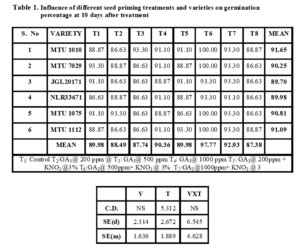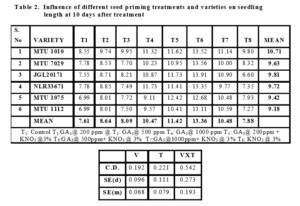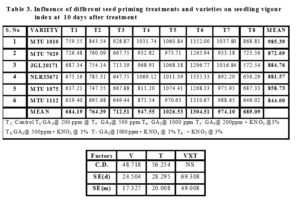INFLUENCE OF SEED PRIMING ON SEED GERMINATIONAND SEEDLINGVIGOUR OF DRY DIRECT SOWN RICE (Oryza Sativa L.).
0 Views
R. PAVANI,V. UMAMAHESH *, A.R. NIRMAL KUMAR AND Y.REDDI RAMU
Department of Crop Physiology, S.V. Agricultural College, ANGRAU, Tirupati- 517502, Chittoor Dt., Andhra Pradesh
ABSTRACT
A laboratory experiment was conducted in completely randomized design and replicated thrice with six popular aerobic rice genotypes i.e. MTU 1010, MTU 7029, JGL 20171, NLR33671, MTU 1075 and MTU 1112, at S.V. Agricultural College, Tirupati. Rice seeds were subjected to different concentrations of gibberillic acid viz., 200,500 and 1000 ppm and combination of both gibberillic acid and KNO3 treatments i.e. GA3 (200 ppm,500 ppm,1000 ppm + KNO3@3%), KNO3@3% and a control (Hydropriming/ Water soaking), in order to know the effect of seed priming on seedling vigour performance under direct seed method. Various physiological observations such as germination percentage, seedling length (cm) and seedling vigour index (SVI) were measured in all six genotypes.
KEYWORDS:
Gibberllic acid, KNO3, Seedling Vigour Index (SVI).
INTRODUCTION
Rice (Oryza sativa L.) is the most important cereal food crop of the developing world and the staple food of more than half of the world’s population. Globally rice is grown over an area of 161.83 million ha with an annual production of 717.8 m t (IRRI, 2017). Irrigated rice is the major consumer of fresh water. Of late water has become the most crucial resource for agriculture especially in Asia and becoming increasingly scarce due to competition from domestic and industrial requirement. It was estimated that by 2025, about 15-20 million hectares of irrigated rice will be affected due to water scarcity which threatens the productivity. Combining the growing demand for food with increasing water scarcity, rice producers in Asia need to produce more rice with less water.
A major challenge in rice production is therefore to save water while maintaining or even increasing the grain yield (Yang and Zhang, 2010). Many water-saving technologies are currently used in rice production, includ-ing alternate wetting and drying irrigation, the rice intensiûcation system, aerobic rice and the ground cover rice production systems (GCRPSs). Among these aero-bic rice is gaining popularity as a strategy for water sav-ing agriculture.
Aerobic rice can achieve yields of 4-6 tons per hectare with 50 – 70 per cent less water compared to lowland rice it does not require flooded wetland (Qu et al., 2012). In aerobic rice production, the seeds are direct-seeded in aerobic soil without any standing water layer, which minimizes water use and boosts up water productivity by eliminating continuous seepage and percolation, reducing evaporation and eliminating wetland preparation (Nie et al., 2012; Singh et al., 2008). Lack of ‘head start’ and the absence of standing water layer to suppress weeds make aerobic rice highly vulnerable to weeds, causing severe yield loss (Zhao et al., 2007) than other rice ecosystems. Season-long weed infestation in aerobic rice may cause yield reduction up to 80 per cent or complete failure of crop in extreme cases (Jayadeva et al., 2011; Sunil et al., 2010).
Seedling vigour is a physiological trait and a sign of potential seed germination, seedling growth and toler-ance to adverse climatic factors. On the other hand, it signiûcantly improves the speed, uniformity and the ûnal percentage of germination, and leads to ideal ûeld appear-ance with good potential grain yield under direct-seeded conditions (Foolad et al., 2007).
Therefore, the aerobic rice cultivars should have seedling vigour i.e. the capacity of early seedling establishment, quick crop growth and yield stability. Identiûcation of strong weed competitive rice cultivar is a feasible solution to inhibit the growth of weeds and it is a cost-effective and safe tool for weed management (Zhao et al., 2006).
Seed priming is a viable option to attain this target. Seed priming, which is also called seed hardening, is a physiological seed enhancement method. It is a pre sowing treatment in which seeds are soaked in an osmotic solution that allows them to imbibe water and go through the first stages of germination, but does not permit radicle protrusion through the seed coat. Subsequently, the seeds can be dried to attain their original moisture content and stored or planted using conventional techniques.
Hence a study was undertaken to through light on effect of seed priming with GA3 and KNO3 either alone or in combination on improvement of seedling vigour.
RESULTS AND DISCUSSION
Germination percentage:
As the genotypes selected for the experiment were all proven for their suitability under dry direct sown condition were possessed with good germination capac-ity. After 5 DAT (Days After Treatment) all the varieties showed a reasonably high germination percentage (89.14 to 91.92 ). However by 10 DAT varieties responded to the treatments positively and recorded further improve-ment in germination. GA3 @ 500 ppm + KNO3 @ 3% (T6) and GA3 @ 1000 ppm + KNO3 @ 3% (T7) recorded significantly high germination percentage. It explained the positive influence of seed priming with GA3 and KNO3 on seed germination. These results are in corroboration with Farooq et al., (2005) (Table 1).
Seedling length
MATERIALS AND METHODS
0.1, 0.25 and 0.5 g each of GA3 (gibberellic acid, HIMEDIA) was dissolved separately 500 ml each in DDW (Double Distilled Water) along with 1.5 g KNO3 in each case to prepare a series of solutions that gives GA3 @ 200 ppm + KNO3 @ 3 % , GA3 @ 500 ppm + KNO3 @ 3 % , GA3 @ 1000 ppm + KNO3 @ 3 %. Three per cent KNO3 was prepared by dissolving 1.5 g of KNO3 in 500 ml of DDW. Seeds were soaked in the respective solutions for 24 h and re dried over night (about 12 h).Well filled and uniform seeds of different varieties were placed on moistened filter paper in glass Petri plates (9 cm diameter) uniformly. After the seeds were placed in the Petri plates, they were moistened in the beginning and at regular intervals with the solutions mentioned above. On 10th day after soaking germination percentage, shoot and root lengths (cm) and SVI were recorded.
Number of seeds germinated
Germination (%) =Total number of seeds kept for germination×100
SVI = (Shoot length + Root length) × Germination percentage
Unlike germination, where only protusion of radicle is an important consideration, seedling length is a reflection of rapid cell division and cell expansion. Faster metabolic turn out in the seed leads to faster growth of the seedling. Thus a clear difference among varieties, treat-
ments and their interaction was observed at 10 DAT.
Thus from the data it was clearly found that MTU 1010 out performed compared to other varieties, except JGL 20171 which recorded highest seedling length at 5 DAT.
Among treatments T6(GA3 @ 500 ppm + KNO3 @ 3%) recorded better results. Interaction effect vividly explained the combined influence of variety and treat-ment on seedling length. Role of seed priming with GA3 resulted in faster increase of seedling length was reported earlier by Helms et al.,1990 and Kumar et al., 2015(Table 2).
Seedling vigour index
Seedling vigour index is a general projection which explains the ability of the seedling to perform better un-der adverse growing conditions. Higher SVI shows abil-ity of the genotype to come up well under aerobic dry direct sown condition. High SVI assures early vigour and
Influence of Seed Priming on Seed Germination and Seedling Vigour of Dry Direct Sown Rice
early biomass accumulation in the initial stages of crop
growth which is highly essential to compete with weeds
during the first 15 to 30 days of crop growing period un-
der aerobic condition.
The data revealed a synergistic role of GA3 and
KNO3 in promoting SVI compared to hydropriming
(control) and osmopriming (KNO3).
The result clearly explained the role of seedling
length in early seedling vigour. Further the interaction
effect was observed to be significantly high in
V1T6(499.69 ,1352.0 and 1885.08) at all the stages. Such
influence of GA3 and KNO3 on seedling vigor index was
also suggested by



REFERENCES
- Farooq, M., Basara S. M. A., Saleem, B. A., Nafees, M and Chishti, S. A. 2005. Enhancement of tomato seeds germination and seedling vigour by osmopriming. Pakistan Journal of Agricultural Sciences. 42(3-4): 36-41.
- Foolad, M., Subbiah, P., Zhang, L. 2007. Common QTL affect the rate of tomato seed germination under different stress and non stress conditions. International Journal of Plant Genomics. 1– 10.
- Helms, R. S., Dilday, R. H and Carlson, R. D. 1990. Using GA 3 seed treatment in direct seeded rice in southern U.S.A. In: Direct Seeded Flooded Rice in the Tropics: Selected Papers from International Rice Research Conference. Pp 113-14. International rice research institute, Manila, Philippines.
- RI, 2017. http://ricestat.irri.org
Jayadeva, H.M., Bhairappanavar, S.T., Hugar, A.Y., Rangaswamy, B.R., Mallikarjun, G.B., Malleshappa, C and Naik, D.C. 2011. Integrated weed management in aerobic rice (Oryza sativa L.). Agriculture Science Digest. 31(1):58–61.
Kumar, S.P.J., Prasad, S.R., Banerjee, R and Thammineni, C. 2015. Seed birth to death: dual functions of reactive oxygen species in seed physiology. Annals of Botany. 1-2
.Nie, L., Peng, S., Chen, M., Shah, F., Huang, J., Cui, K and Xiang, J. 2012. Aerobic rice for water-saving agriculture. A review of Agronomy and Sustainable Development. 32:411–418.
Qin, Y., Liu, S., Guo, Y., Liu, Q and Zou, J. 2010. Methane and nitrous oxide emissions from organic and conventional rice cropping systems in Southeast China. Biology and Fertility of Soils. 46: 825834. - Qu.et al., Tao, M.B., Tao.Y.Y., Liu, M.J., Shen, K.R and Lin, S. 2012. Ground cover rice production system increases yield and nitrogen recovery effi-ciency. Agronomy Journal. 104.1399-1407.
- Singh, A.K ., Pal, S., Datta, S.P., and Rattan, R.K . 2008. Diagnosis and amelioration of iron deficiency under aerobic rice. Journal of Plant Nutrition. 31(5):919-940.
Sunil, C.M., Shekara, B.G., Kalyanmurthy, K.N and Shankaralingapa, B.C. 2010. Growth and yield of aerobic rice as influenced by integrated weed management practices. Indian Journal of Weed Science. 42(3):180-183.
Yang, J and Zhang, J. 2010. Crop Management Techniques to enhance harvest index in rice. Journal of Experimental Biology. 61(12):3177-3189.
Zhao, D.L., Atlin, G.N., Bastiaans, L and Spiertz, J.H.J. 2006. Cultivar weed competitiveness in aerobic rice: Heritability, correlated traits, and the potential for indirect selection in weed-free environment. Crop Science. 46:372–380.
Zhao, D.L., Bastiaans, L., Atlin, G.N and Spiertz, J.H.J. 2007. Interaction of genotype 9 management on vegetative growth and weed suppression of aerobic rice. Field Crops Research. 100:327-340
- Bio-Formulations for Plant Growth-Promoting Streptomyces SP.
- Brand Preference of Farmers for Maize Seed
- Issues That Consumer Experience Towards Online Food Delivery (Ofd) Services in Tirupati City
- Influence of High Density Planting on Yield Parameters of Super Early and Mid Early Varieties of Redgram (Cajanus Cajan (L.) Millsp.)
- Influence of Iron, Zinc and Supplemental N P K on Yield and Yield Attributes of Dry Direct Sown Rice
- Effect of Soil and Foliar Application of Nutrients on the Performance of Bold Seeded Groundnut (Arachis Hypogaea L.)

